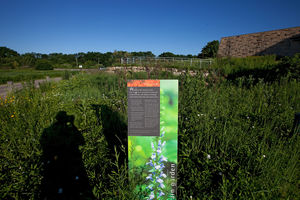
A rain garden is a low lying area, planted with suitable species, that allows rainwater runoff from impervious urban areas such as roofs, concrete bitumen, or compacted soil or lawn areas the opportunity to be absorbed. Thus it functions as groundwater recharge, allowing stormwater to soak into the ground, and is a variation on the concept of the swale.
Ideal plants for rain gardens are those which don't require fertilizer and are tolerant of the local climate, soil, and water conditions. For this reason, native plants are often suitable - however they must be tolerant of the periodic flooding and higher average exposure to water in a rain garden, compared to many sites in the same area. Wetland edge vegetation, such as wildflowers, sedges, rushes, ferns, shrubs and small trees can be suitable.
Water filters through the soil, and is partly taken up by the plants, before entering the groundwater. Plant root systems and activity by earthworms and other creatures also keep the soil open and enhance infiltration, moisture redistribution, and diverse microbial populations, thus enhancing biofiltration.
A wider definition can be used, under which a whole garden can become a rain garden.
Why[edit | edit source]
- Keep local waterways cleaner
- Reduce flooding
- Less grass to mow
- Less need for other expensive measures such as
Design[edit | edit source]
For example, a parking lot drains to a rain garden. A sunken curb retains asphalt, thus reducing this source of pollution, but lets water flow off the edges.
To do detailed calculations, consider:
- the area of surface to be drained (e.g. roof). Consider also whether there is additional runoff from elsewhere, during very heavy rainfall.
- rainfall during rainy periods at the location,
- do a "percolation" test to determine how fast the soil will take the water. Remember this will vary with whether it is planted and healthy, or compacted.
This can let you work out what size the garden should be.
However, if successful rain gardens have been built in your community, you may only need to consider the area of the successful gardens, relative to the surface that it drains, and use the same proportion. However, note any differences in soil, and whether, for example you live in a rainier part of the city.
Stormwater mitigation[edit | edit source]
Stormwater mitigation consists of using:
- Minimal area of paved surfaces
- Medium or high-density housing - this reduces roof area and leaves much more space for open and green space.
- Rainwater harvesting - this is limited in effectiveness, however, the mitigation benefits cease once the tank is full.
- Porous surfaces such as porous pavement,
- Stepping stones instead of paved paths
- Grassy paths (where traffic is low)